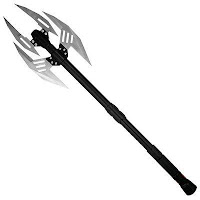In our film the costumes are important as the costumes will reflect the character type. An example will be the killer (adversary) as the killer character will have dark clothing to represent fear and also to put fear into the audience. The sort of costume the killer will wear is ripped, dark and blood on the clothing so that the audience know what type of character he or she is. The protagonist will have better clothing that the adversary as the audience would get confused if they both wore the same sort of clothing. The protagonist will wear more better and updated clothing as the protagonist will represent as non violent.
Props
In our film the props we are using will weapons, the weapons will be unique and will also show what kind of genre it is (example if you see guns in a fight scene then you would expect it to be action, you also don't see guns in horror). Our aim is for the character to look scary with the weapon, the weapon will be unique because it will appear to the audience as a surprise and will want to watch more because they will want to know how the character use's it.
In our film the props we are using will weapons, the weapons will be unique and will also show what kind of genre it is (example if you see guns in a fight scene then you would expect it to be action, you also don't see guns in horror). Our aim is for the character to look scary with the weapon, the weapon will be unique because it will appear to the audience as a surprise and will want to watch more because they will want to know how the character use's it.
Lighting
In our film the lighting will be low key lighting, when the adversary is in a camera shot such as a ECU (extreme close up) then the lighting will be dark however when the protagonist is in a camera shot then the lighting will be brighter than when the adversary is in the shot. When the adversary is hunting the protagonist the lighting will be dark to create tension so that there is a build to when the protagonist is nearly killed. The lighting will be mostly dark, when the camera is filming adversary character the background will be light but the adversary will be a dark figure so you can't see his face until he comes and bit closer so there will be a lot of contrast in our film, this is to create tension and also to scare the audience.
In our film the lighting will be low key lighting, when the adversary is in a camera shot such as a ECU (extreme close up) then the lighting will be dark however when the protagonist is in a camera shot then the lighting will be brighter than when the adversary is in the shot. When the adversary is hunting the protagonist the lighting will be dark to create tension so that there is a build to when the protagonist is nearly killed. The lighting will be mostly dark, when the camera is filming adversary character the background will be light but the adversary will be a dark figure so you can't see his face until he comes and bit closer so there will be a lot of contrast in our film, this is to create tension and also to scare the audience.
Mis-En-Scene
The mis-en-scene is the setting within a film, the settings gives the audience the type of genre the film is, an example of this would be a high built up and busy area would be a a genre of action as many action films consist of this type of mis-en-scene to escape as it's a busy area. For our film the mis-en-scene decision is the woods as of which was based on our film genre which is horror, our group decided on this as the woods can be a scary place with the lighting (dark - natural light) in the woods as this would be an uncomfortable situation as you wouldn't be able to see what is lurking around such as an unusual creature in that kind of darkness.








No comments:
Post a Comment